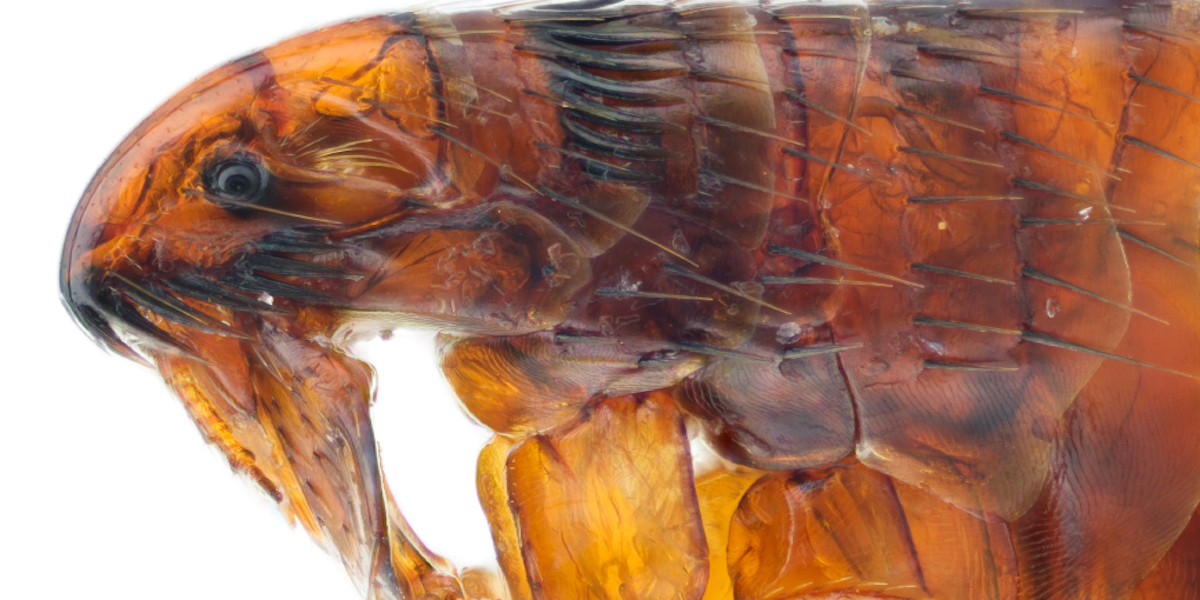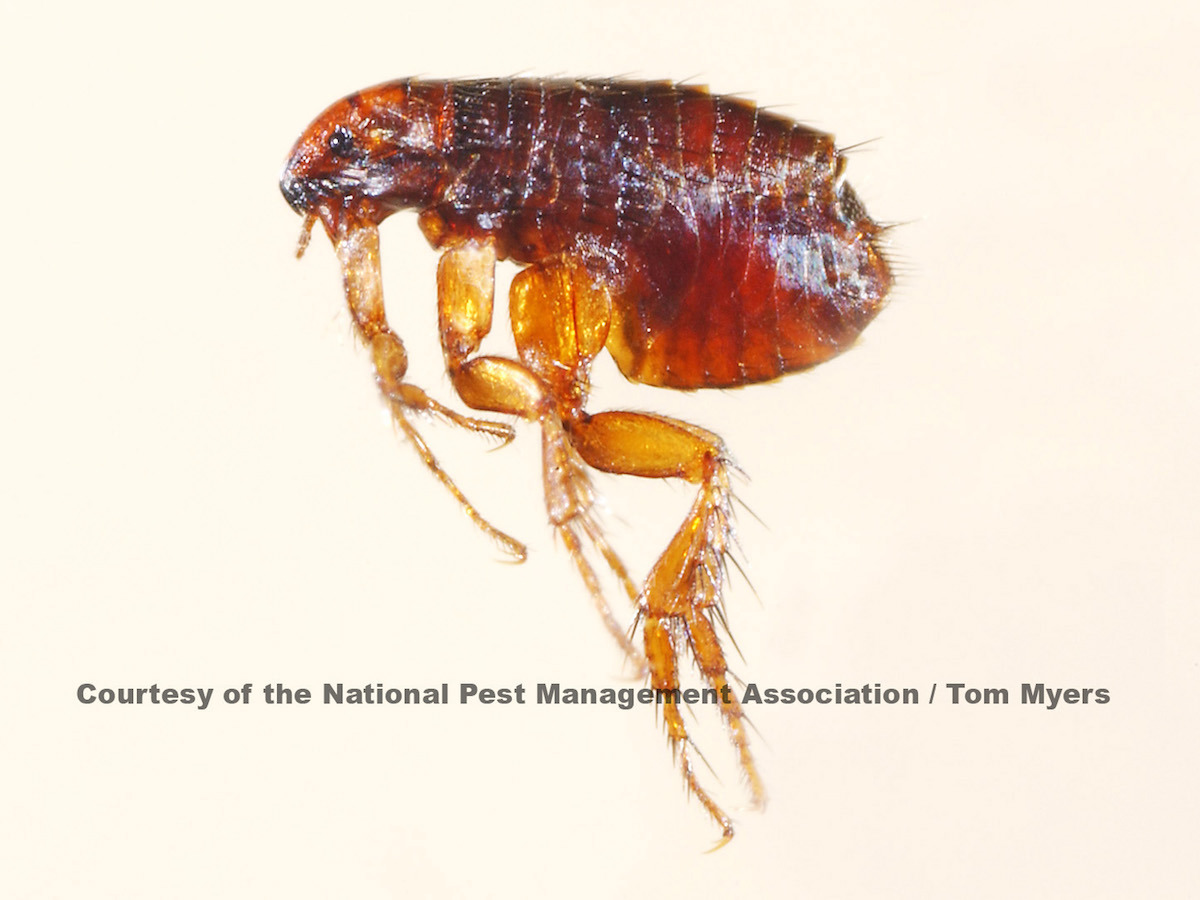Cat Flea Ctenocephalides felis

Cat Flea Identification
Color: Brownish black to black in color, but may appear reddish black when full of blood
Size: 1/8” (2.5 mm) long
Legs: 6
Antennae: Yes
Shape: Flat
Region: Found throughout the United States
What Are Cat Fleas?
Fleas are parasites that feed on the blood of any warm-blooded body. They are one of the more significant groups of pests because they not only cause discomfort by biting, but they can transmit several diseases. Cat fleas are the most common domestic flea. They are found throughout the United States and the rest of the world, most often on cats and dogs. However, they can also be found on other urban hosts, including opossum, fox, mongoose and occasionally rats. Keep reading to learn about cat fleas, including how to identify cat flea bites.
What Do Cat Fleas Look Like?
Adult cat fleas are about 1/8" in length. Their bodies are laterally flattened and brownish black to black in color. Cat fleas may appear reddish black when full of blood. Female cat fleas have disproportionately small heads, as they are twice as long as they are high. Cat fleas are wingless and have six legs with the hind ones capable of helping them jump large distances. Cat flea eggs are about 1/64 (0.5 mm) long. They are oval and white.
Cat flea bites can cause itchy, swollen red bumps. If a cat flea bites you, try to refrain from scratching the affected area. First aid is similar to that of a wasp sting. Clean the area with soap and water and use an ice pack to minimize swelling. An antihistamine and hydrocortisone ointment may also be administered. Seek out immediate medical assistance if the cat flea bite causes symptoms of an allergic reaction, such as wheezing and shortness of breath, appear.
Female cat fleas lay 4-8 eggs after a blood meal and can produce 400-500 offspring during their lifetime. The eggs are deposited on or between the host’s hairs, or in nests or bedding materials. Eggs deposited on a cat or dog are likely to fall off or get shaken off. For this reason, cat flea eggs are often found in cracks and crevices where pets sleep or frequent, including along their usual avenue of travel. Cat flea eggs usually hatch in about two days.
Cat flea larvae have chewing mouthparts and feed on organic debris. While cat flea larvae do not bite, they will feed on dried adult fecal blood. This is required in order to complete development. Most larvae will be found in similar places as the eggs, but especially in areas with high humidity which is necessary for their survival. Cat flea larvae spin cocoons and remain in them for up to 20 weeks. The pupae stage may last anywhere from four days up to a year depending on the conditions. A few factors encourage adult cat fleas to emerge from the cocoons. These factors include an increase in temperature, vibrations and mechanical depression of the cocoon itself. Adult cat fleas usually seek a blood meal on the second day after emerging from the cocoon. However, they can live for several months on their stored body fat without a blood meal.
Unlike many other types of fleas, adult cat fleas will spend all of their time on a host, where they feed, mate and lay eggs. Depending on the conditions, adults usually only live several days because they are dislodged when a cat or dog is groomed.
Cat fleas bite humans if they are dislodged from their animal host. Their saliva can cause serious flea dermatitis in pets and their debris has been reported to cause similar allergic reactions in humans.
Cat fleas have been implicated in the spread of plague and the bacterial disease murine typhus through rats. They can also transfer tapeworms, specifically the dog tapeworm, Dipylidium canninum (Linnaeus), and the rodent tapeworm, Hymenolepis diminuta (Rudolphi). These tapeworms occasionally infest humans, especially very young children. The dog tapeworm infests cats that spend time outdoors.
Fleas are relatively easy to see in their adult stage; therefore, seeing actual fleas is the most obvious sign of an infestation. Observing a pet excessively scratching, licking or biting at their skin is another sign of a cat flea infestation.
Fleas can be present even if a home or building has been vacant of animals and people for as long as six months. This situation can occur because of the potentially long pupal period and because fleas have not been removed via normal vacuuming.
Looking to prevent and get rid of cat fleas in the home? Flea control is a process that requires the partnership of a homeowner and a licensed pest control professional.
When it comes to cat flea prevention, homeowners should make their property less appealing to rodents and nuisance wildlife, which serve as cat flea hosts, by keeping the lawn groomed. Also, seal all cracks and crevices using a silicone-based caulk, steel wool or a combination of both, and screen vents and openings to chimneys. A licensed pest control professional can inspect the property and identify areas conducive to these invaders. On the other hand, pet owners should practice active flea management by keeping dogs on a leash when outside, bathing and grooming pets regularly, visiting a veterinarian annually, and using flea treatments according to direction.
If a cat flea infestation is suspected, contact a licensed pest control professional for assistance. He or she will recommend a proper course of treatment, which usually includes vacuuming all upholstered furniture, floors and carpeting, paying close attention to the foot of the furniture where a cat or dog might lay. The vacuum bag must be immediately removed and put into a sealed plastic garbage bag outside of the residence.




